 The end of the school holidays and the start of term needn't be such a pain in the neck - or the back. I walked with my niece to her school the other day and was amazed at the weight of her school bag - not to mention her hockey stick, PE kit, packed lunch - and all the other stuff that she needed for the day. It's not surprising then that back pain is on the increase in our youngsters, but a few simple tips can make the start of term a bit less painful... • Bag it up - a rucksack really is the best option, as long as your child carries it over both shoulders, with the straps are adjusted so that the bag is held close to their back and heavier items are placed at the top of the rucksack. They'll probably hate you for it now, making them look like a nerdy swot, but they'll thank you for it later in life when they haven't got such a sore back! • Keep it light - your child should avoid carrying any excess weight in their bag – check it every day to make sure they aren’t carrying any unnecessary items. Encourage the school to provide lockers so that they don't have to carry all their heavy books around all the time. • Best foot forward - wearing good, soft-soled shoes that are supportive and have a good grip on the ground will make carrying a heavy bag much easier. Ensure shoes laces are tied up properly for support (again, much cooler to have them undone, socks around the ankles - but just remind them that it's much less cool to have a broken ankle!). • Move around - staying still for a long time is bad for the spine. Limit your child to 40 minutes on their phone, laptop, tablet, and computer or in front of the TV then encourage them to get up and do something else for a while. Hint - Hide the remote control so they have to get up to change channel. • Keep fit - Regular and frequent exercise is best - the fitter they are, the less likely they are to injure themselves. Drag them out at the weekends or make the most of this late summer sunshine and head out after school. Encourage them to take up a new sport or active hobby. Exercise is good for us grown-ups too - set a good example and get out there! Ditch the car and walk or cycle them to school - and then carry on to work. These few simple tips can help to make things more comfortable and reduce the risk of back and neck pain. Ultimately, this'll hopefully make for a happier, healthier child (certainly less whingy!).
0 Comments
 With spring approaching, the days lengthening and the wintry sun gradually warming up the air, we're beginning to come out of 'hibernation'. We're generally getting a little more active - out into the garden, spring-cleaning, attacking that DIY project in the house, or taking a bit more exercise than we have during what seems to have been a long winter. Despite our enthusiasm, it's important to take things gently at first, letting the muscles and joints warm up. Every Monday morning, the phone in the clinic rings non-stop, with people who have 'overdone it' in the house or garden at the weekend. Whilst some gentle exercise is generally good for the back, overexertion can cause problems. Try to ease yourself into it - do some gentle stretches and warm up exercises first (marching on the spot, shrugging the shoulders, circling the arms) to get the blood circulating through the muscles, and pace yourself. Do lots of different jobs, changing your posture and position regularly, rather than concentrating on the one thing for too long. Listen to your body too - if something is niggling or painful, stop and don't be tempted to 'work through the pain' - it is your body telling you something isn't right. If the niggle persists, or worsens, phone the clinic and get advice! A simple, 3-minute stretching exercise routine is Straighten Up that will keep the body supple and loose if practised regularly. As so perfectly demonstrated by this poor little penguin and his unhelpful, mocking friends, venturing out in this cold, icy weather can be treacherous! Even a simple slip on an icy pavement can result in at least a jarred back, grazed knees or a banged bottom (not to mention a dented ego!) - or worse still a fractured wrist or even hip which may take months to heal (my husband is looking at 3 months in a cast after fracturing his scaphoid - a very small bone in the wrist! OK, we were snowboarding!!!). However, whilst it is tempting to stay snuggled up indoors, this is not always possible and even in the cold weather our bodies benefit from a little bit of fresh air and exercise.
With a few simple, sensible precautions you can avoid the fate of the penguin...
Now, how about another look at that penguin... 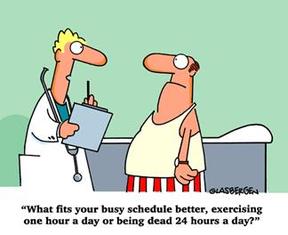 A recent study, published in the European Spine Journal, investigated the link between levels of physical activity, physical fitness and the incidence of low back pain. The study was conducted in the Netherlands and asked a population of police officers about their activity levels and episodes of low back pain over the preceding 12 months. In addition to questioning, their levels of physical fitness were actually measured objectively (hence minimising the problem that often arises with this sort of study where people inaccurately record their activity levels, often tending to over-report). Results were collected from nearly 2000 individuals and the findings were conclusive - moderate levels of physical fitness (both muscular and aerobic) correlated with a lower incidence of low back pain, whereas the occurrence of low back pain increased with lower levels of activity and physical fitness. So, the implications of this are clear - exercise regularly, improve your fitness levels and you should experience fewer episodes of low back pain! However, it is not quite that simple - it may be that people refrained from exercise due to their low back pain, hence their back pain worsened, hence they exercised less - something of a Catch22 situation! Additionally, the findings showed that excessive levels of exercise actually increased the episodes of low back pain - this was particularly true of highly strenuous, vigorous activities such as weight lifting or heavy gardening and was a problem that mainly affected the male cohort of the study. In conclusion, this study showed that physical activity, strenuous enough to improve physical fitness, was strongly associated with lower levels of low back pain. So, the message is clear - get moving, get fit and you should have less low back pain (but take it gently and sensibly as excessive exercise might cause more harm than good!). 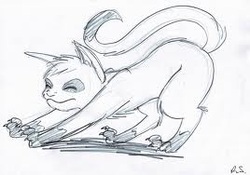 Have you ever watched an animal as it prepares to settle down for a nap? Or seen what it does on waking? It stretches. OK, so it might have a bit of a wash too, or circle the ground a few times (apparently dogs do this from their 'wild days' when they would flat down a circle of grass to make a comfy bed), but it will always take time to stretch. This is one of the many things that we humans have forgotten to do as we've evolved, but stretching regularly is really useful - it eases out the joints, loosens the muscles and helps the circulation. One of my favourite stretches is the Cat Stretch; it's quick and easy to do and loosens up the entire back, stretching out all the long muscles that run parallel to the spine and mobilising all the little joints between each vertebra. I encourage most of my patients to do it every day, morning and evening - those that do generally feeler looser and easier with less stiffness and fewer aches and pains. 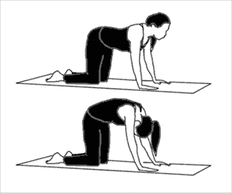 The Cat Stretch Start off on all fours, hands below your shoulders, knees below your hips. Make sure you're evenly balanced, keep your arms straight and strong and draw your belly button in towards you spine so your tummy doesn't 'sag' down to the floor. Gently arch your back, pushing your rib cage up to the ceiling, tucking your chin to your chest and your bottom underneath you (think of a dog tucking its tail between its legs!). Hold for a count of three, then gently lower back down to the starting position. Don't be tempted to arch the other way, sagging in the middle and sticking your bottom and head out, as this can over-arch the lower back and jam all the joints together - keep your back flat with your tummy muscles gently supporting your spine. Repeat this whole sequence 10 times or so, and do it every morning when you're getting up and last thing before bed. It only takes a couple of minutes and will really help to keep the spine healthy - a bit like cleaning your teeth twice a day keeps your teeth healthy! Sore knees? You can easily do this kneeling on your bed or on a couple of cushions. If it's still too much for your knees then you can do a 'half cat' - stand facing a wall, place your hands on the wall at shoulder height with your knees slightly bent and gently arch your back. Repeat 10 times, morning and evening. Obviously, if you find this stretch uncomfortable, painful or difficult to do, please be sensible and don't do it! Email me, or give me a call and we can work out what the problem is.  Things are hotting up at the London 2012 Olympics. Only a few more days until the Opening Ceremony... This week, the doors of the Athletes Village will open. Athletes and their support teams from 204 countries will start arriving. And, for the first time, chiropractors will be there! Within the Athletes Village is the state of the art Polyclinic. Open 24 hours a day this multidisciplinary clinic is kitted out with some of the most sophisticated equipment in the country and staffed by highly skilled specialists - including, for the first time ever, chiropractors. It is expected that a high proportion of the anticipated 200 competitors visiting the polyclinic each day will be suffering from musculoskeletal injuries - sprains, strains, muscle injuries and joint pains - exactly the sort of problems that we chiropractors excel in treating. So, it is expected that the team of chiropractors are going to be kept busy, providing care from 7am - 11pm every day, with 24 hour emergency 'on-call' cover as well!  The state of the art Polyclinic in the Olympic Village The team of chiropractors will be working alongside other musculoskeletal healthcare specialists - orthopaedic surgeons, neurologists, sports injury physicians - as well as other core services like dentistry, optometry, and physiotherapy. Together, this team of medical specialists will help to ensure that athletes are in their peak condition for this most important time in their sporting careers.  Richard Brown meets Lord Coe Richard Brown, chiropractor and President of the British Chiropractic Association is one of the chiropractors who has taken time out of his busy practice and professional schedule to be treating the athletes. He had the opportunity to meet Lord Coe, Chairman of LOCOG, who voiced his support at the presence of chiropractors at the Olympics, and who said that his own career would have been far shorter, had it not been chiropractors. Hopefully, Richard and the other chiropractors in the Polyclinic will be able to keep the competitors in tip top condition; here's hoping that they enable Jessica Ennis and a few of her fellow competitors to bring home some shiny medals...! 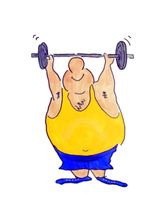 None of us are getting any younger. That's something that we really can't do anything about; we can't stop the clock, or even slow it down. However, we can do something about it. I love the saying 'use it or lose it' and when it comes down to the body, that really is the case. This year, 2012, marks the 'European Year for Active Ageing'; an initiative set up by the European Union to recognise the increasing ageing population, and to raise awareness of the contribution that the older generation makes to society. The European Year encourages 'active ageing' with emphasis placed on the maintenance of good health and wellbeing, and an active, independent lifestyle, fully integrated and incorporated into the wider society. In recognition of this initiative, and as part of Chiropractic Awareness Week (16th to 20th April), we chiropractors have done a bit of consumer research*, the results of which highlight the need for action and attention, whatever your age, shape or size:
However, despite our concerns, we can do something about it! Like a car, or any well-oiled machine, keep the body moving gently on a daily basis and it'll generally keep going for longer. Remaining active as we grow older is vital for our overall wellbeing and continued health, and a few simple steps can be taken to help preserve your back and posture for years to come:
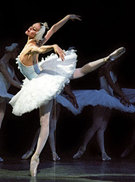 _I was lucky enough to get tickets to see the Moscow City Ballet's production of 'Swan Lake' at Venue Cymru in Llandudno earlier this week. This production has become a 'must see' for all those who dipped their toes into ballet after seeing 'Black Swan' in the cinemas last year, but has been high up on my list for a long time. Swan Lake follows the love story of a prince who is entranced by Odette - a beautiful maiden trapped in the body of a graceful swan by an evil sorcerer - and her nemesis, Odile the black swan. Swan Lake was fantastic - the sheer grace and beauty of the dancers as they effortlessly leapt about the stage, lithe-limbed and ethereal. It was amazing to see how they managed to transform themselves from human to swan, simply by changing the movement of an arm or leg. What was even more impressive was the way that they managed to make it look completely effortless - and yet ballet has to be one of the hardest forms of exercise. Dancers have to be incredibly fit; strong and supple with immense stamina to be able to perform for 2-3 hours every evening, in addition to hours of practice and rehearsal during the day. I think that dance, and in particular ballet, must work pretty much every muscle in the body and relies on very good 'core stability'. A lot of dancers practice Pilates to keep these core muscles strong; one of the best workout DVD's I use is Darcey Bussell's 'Pilates for Life' (Darcey was a prima ballerina with the Royal Ballet for many years) and many of the exercises I prescribe for patients are based on Pilates. Obviously, chiropractic is used extensively within the ballet world - most of the big dance companies have their own chiropractor as part of the medical team - and I'm sure those that have seen 'Black Swan' will remember the scene where she has her foot and ankle manipulated with an almighty 'crack'! Seeing Swan Lake has once again shown me how impressive the human body can be, and has rekindled my passion for ballet. I danced for many years as a child, but have recently taken it up again at the Barton Dance and Drama Academy in Holyhead. There is nothing that stretches the mind and the body quite like a hard session at the barre - and who knows, maybe one day I'll realise my dream of being a ballerina! 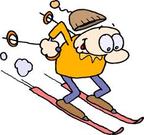 _ It's that time of year when many of us will be hitting the slopes. Whether it being carving those parallel turns or flipping 180's in the board park, it's never too soon to start getting fit for the snow. A little bit of work at this stage will enable you to minimise injuries and maximise your time on the snow. Some pre-season fitness tips... Improve your overall cardiovascular fitness - cycling, running, 'bunny hops', roller blading and bouncing on a mini-trampoline will help to build up your overall fitness and strengthen those all important thigh muscles. Feel the burn - strengthen the quad muscles and improve your core stability with squats and travelling lunges and wall sits. I've found a great explanation and demonstration here. Get to the core - planks, sits-ups and exercises on a gym ball or wobble board will help to improve your core stability and sense of balance. On the slopes... Hot and cold - warm up gently at the start of the day with a walk to the first lift and few easy runs to loosen up any tired, achy muscles; don't head straight for the black runs! Watch out for icy patches. Be careful on that 'one last run before we finish' - tired legs, heavy wet snow and a thirst for the après ski are a recipe for disaster (it's sometimes better to skip the last lift and head to the bar early!) Easy does it - take plenty of breaks, listen to your body and pace yourself. Skiing hard on days one and two will just ruin the rest of your holiday. Most skiing injuries and accidents apparently happen on day three when the confidence levels are high, but energy levels are low. Liquid lunch - drink plenty of water and isotonic drinks to keep hydrated, and avoid tea, coffee and alcohol. Be careful of the 'lunchtime lethargy' - the wobbly legs and a sleepy head on the first post-lunch run after loading up on tartiflette! Kit-check - choose your boots carefully - head for a shop with a wide range, get them heat-moulded if possible, and if they're not right, change them. Poor fitting boots and bindings will hinder your progress - no matter how good your technique! Make sure you've got the right kit with you - skiing down in a white-out without my goggles wasn't much fun (it was sunny when I left the chalet!!). Ice is nice - With an acute injury, use ice rather than heat. Take a couple of plastic bags with you and fill up with snow! Following these tips will hopefully allow you to make the most of your trip - most importantly, remember that it's a holiday and make sure that you have fun and enjoy it! I find it much harder to motivate myself to go out for a run on these cold, dark windy evenings, but I know that I always feel better for it once I have dragged myself off the sofa! I find that the worst bit is getting out of the front door, but I tell myself that I'll only go out for five minutes and invariably stay out longer.
I did just that this evening having slobbed out for too long and eaten too many crumpets. It was really chilly out, but I wrapped up warm, donned my highly attractive, but highly visible reflective jacket and head-torch, and headed off around the village. I felt a bit like an oversized glow-worm as I was trying out my new flashing 'tail' light (if only it was green...!) – but at least it made me a bit more noticeable. Heading out in the evenings is great; with less to see you really focus on your other senses – the bark of a fox in the distance, or a robin chirruping in the trees, confused by the artificial light of the streetlamps. I love catching a glimpse into other people's lives through their un-drawn curtains and really notice the smell of the autumn leaves mingled with the acrid scent of a coal fire that hangs in the damp, cold air. As always, it was definitely worth heading out into the cold. My cheeks were pink and glowy and I felt refreshed and invigorated - and more worthy of a lazy, relaxing evening. After all, I'd earned it! |
Ceri AnnEich Ceiropractydd yng Nghlinig Ceiropracteg Llangefnii Blogumulus by Roy Tanck and Amanda Fazani
Archives
June 2020
|
Llangefni Chiropractic Clinic, 6 GlanHwfa Rd, Llangefni LL777EN, Anglesey, North Wales, UK privacy policy Llangefni Chiropractic Clinic 2020
 RSS Feed
RSS Feed



